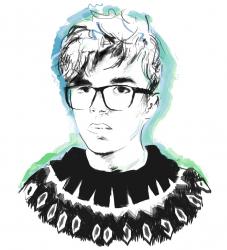When Jóhanna Bergmann Þorvaldsdóttir’s goat farm ran into financial difficulties a couple of years ago, it looked like the end of the line for the Icelandic goat. Nearly one year on from a successful crowdfunding campaign to save the farm, the Háafell goat centre is leading the way in goat conservation, with Jóhanna working hard to breed more goats—and produce new and exciting goat products. We caught up with her in the farm’s well-tended rose garden to see how things are going.
SPECIAL SPECIES
Last year, you ran a crowdfunding campaign to save the Icelandic goat, right?
This farm was saved last autumn thanks to crowdfunding. We had donors from all over the world—from places as far as South Korea, Nepal, and Malaysia. It was really amazing. I got enough money to deal with the bank and start over.
So this autumn, we are starting to build a cheesemaking room—a little house on the side of this building—to make some goat cheese. Right now, the goats’ cheese I have is made at Erpsstaðir—a little dairy farm that does ice cream and skyr. Would you like to taste?
Sure!
[At this point, Jóhanna leaves the room briefly, only to return with two jars of goat cheese. It receives the official Grapevine verdict of “confirmed deliciousness.”]Nom. MMM. Okay, so what makes the Icelandic goat so unique?
They are now a special species, because they have been isolated here for 1100 years. No goats have been imported in that time. They are therefore the purest old breed you find in Europe—similar to our horses.
I read that there were not many Icelandic goats left when you launched the campaign. What happened to them?
In the old days, a lot of goats came with the Vikings. But then it got colder—there was this mini Ice Age, we call it—around the 12th or 13th century. People needed fat meat to survive, and they needed wool. So the sheep became the saviour of Iceland, and has been ever since. But it was always goats up to that point.
In the 1930s, we had 3,000 goats in Iceland, mostly in small towns on the coast. After the war, though, we learnt to grow gardens as we got richer and modernised. The goats love gardens, but it was forbidden to keep livestock in towns. So after that, the goats nearly all disappeared. The farmers had cows and it was a kind of sign of poverty to have goats—not something a noble farmer wanted to have.
Even today, the old sheep farmers are the worst enemies of the goats. My father never allowed me to have a goat when I was a kid, because he said they weren’t even edible—that they were naughty, that they were bad, and that they smelled bad. But he only knew this from old myths. The goat was actually the first animal to live with humans. Dogs came after.
THE GOATS ESCAPE!
How are they doing today?
There are nearly 900 now. In 1962, there were around seventy to eighty Icelandic goats, and just one hornless goat. The hornless goat had certain genes—no horns and a unique brown colour. So it was just one goat that saved all these beautiful colours.
In 1999 when I got the rest of them, there were just four left, and they were on their way to slaughter. So I was allowed to move them here.
[Jóhanna looks out of the window. Some of the goats have escaped.]Oh, one got out. Oh. Many got out!
[After a brief wrangle with some goats, Jóhanna returns.]If I had lost the farm last year and the goats had been slaughtered, fifteen years of breeding would have disappeared. We would be at square one all over again. However, people are now very interested in the cheese, in the meat—everything. Fifteen years ago, people would shake their heads and say, “Goats aren’t even edible!”
Since then, this has been my mission: to breed these kind of goats and to teach Icelanders to once again use goat products. Most people who have goats keep them as pets. They don’t think of different goats as related to each other. Really, we need three other farms like this, all working on breeding.
Do you think conservation is important, then?
We shall preserve everything we have. We have beautiful breeds of animals in Iceland. Instead of trying to import bigger cows, for example, something that gives more milk but requires more corn, we shall take care of what is here. Importing bigger animals is not what fits us. We’re going to look a lot more at what we already have.
So is the Icelandic goat finally saved?!
Once I can make my own cheese, I hope then it will finally be saved. Then I have a product to sell all year around. People are waiting for the cheese, they’re really waiting for it.
Buy subscriptions, t-shirts and more from our shop right here!




























